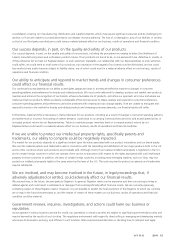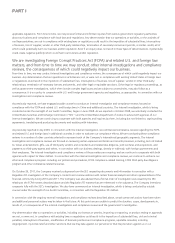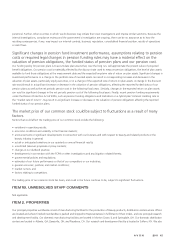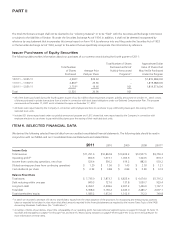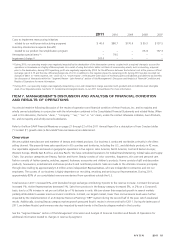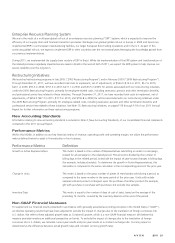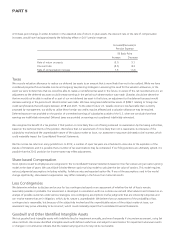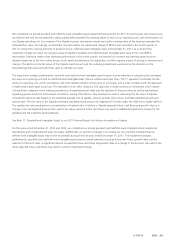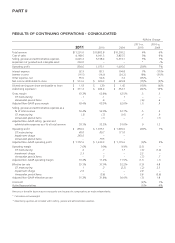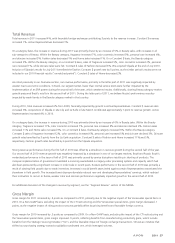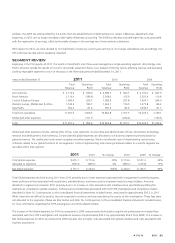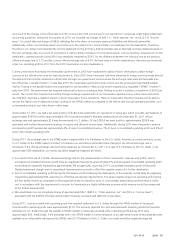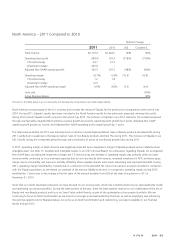Avon 2011 Annual Report Download - page 31
Download and view the complete annual report
Please find page 31 of the 2011 Avon annual report below. You can navigate through the pages in the report by either clicking on the pages listed below, or by using the keyword search tool below to find specific information within the annual report.Provisions for Inventory Obsolescence
We record an allowance for estimated obsolescence equal to the difference between the cost of inventory and the estimated market value.
In determining the allowance for estimated obsolescence, we classify inventory into various categories based upon its stage in the product
life cycle, future marketing sales plans and the disposition process. We assign a degree of obsolescence risk to products based on this
classification to determine the level of obsolescence provision. If actual sales are less favorable than those projected by management,
additional inventory allowances may need to be recorded for such additional obsolescence. Annual obsolescence expense was $128.1 for
2011, $131.1 for 2010, and $120.0 for 2009.
Pension, Postretirement and Postemployment Expense
We maintain defined benefit pension plans, which cover substantially all employees in the U.S. and a portion of employees in international
locations. Additionally, we have unfunded supplemental pension benefit plans for some current and retired executives and provide retiree
health care and life insurance benefits subject to certain limitations to the majority of employees in the U.S. and in some foreign countries.
See Note 12, Employee Benefit Plans, to our 2011 Annual Report for further information on our benefit plans.
Pension plan expense and the requirements for funding our major pension plans are determined based on a number of actuarial
assumptions. These assumptions include the expected rate of return on pension plan assets, the interest crediting rate for hybrid plans and
the discount rate applied to pension plan obligations.
For 2011, the weighted average assumed rate of return on all pension plan assets, including the U.S. and non-U.S. plans was 7.54%,
compared to 7.65% for 2010. In determining the long-term rates of return, we consider the nature of the plans’ investments, an
expectation for the plans’ investment strategies, historical rates of return and current economic forecasts. We evaluate the expected long-
term rate of return annually and adjust as necessary.
The majority of our pension plan assets relate to the U.S. pension plan. The assumed rate of return for 2011 for the U.S. plan was 8%, which
was based on an asset allocation of approximately 40% in corporate and government bonds and mortgage-backed securities (which are
expected to earn approximately 4% to 6% in the long term) and 60% in equity securities and high yield securities (which are expected to earn
approximately 7% to 10% in the long term). Historical rates of return on the assets of the U.S. plan was 6.5% for the most recent 10-year
period and 7.9% for the 20-year period. In the U.S. plan, our asset allocation policy has favored U.S. equity securities, which have returned
4.5% over the 10-year period and 8.3% over the 20-year period. The plan assets in the U.S. returned 7.0% in 2011 and 14.0% in 2010.
Recently issued regulations under the Pension Protection Act of 2006, though not yet finalized, require that hybrid plans limit the maximum
interest crediting rate to one among several choices of crediting rates which are considered “market rates of return”. The rate chosen will
affect total pension obligations. The discount rate used for determining future pension obligations for each individual plan is based on a
review of long-term bonds that receive a high-quality rating from a recognized rating agency. The discount rates for our more significant
plans, including our U.S. plan, were based on the internal rates of return for a portfolio of high quality bonds with maturities that are
consistent with the projected future benefit payment obligations of each plan. The weighted-average discount rate for U.S. and non-U.S.
plans determined on this basis was 4.69% at December 31, 2011, and 5.21% at December 31, 2010. For the determination of the expected
rate of return on assets and the discount rate, we take into consideration external actuarial advice.
Our funding requirements may be impacted by regulations or interpretations thereof. Our calculations of pension, postretirement and
postemployment costs are dependent on the use of assumptions, including discount rates, hybrid plan maximum interest crediting rates and
expected return on plan assets discussed above, rate of compensation increase of plan participants, interest cost, health care cost trend
rates, benefits earned, mortality rates, the number of associate retirements, the number of associates electing to take lump-sum payments
and other factors. Actual results that differ from assumptions are accumulated and amortized to expense over future periods and, therefore,
generally affect recognized expense in future periods. At December 31, 2011, we had pretax actuarial losses, prior service credits, and
transition obligations totaling $483.1 for the U.S. plans and $284.7 for the non-U.S. plans that have not yet been charged to expense. These
actuarial losses have been charged to accumulated other comprehensive loss within shareholders’ equity. While we believe that the
assumptions used are reasonable, differences in actual experience or changes in assumptions may materially affect our pension,
postretirement and postemployment obligations and future expense. For 2012, our assumption for the expected rate of return on assets is
7.13% for our U.S. plans and 6.85% for our non-U.S. plans. Our assumptions are reviewed and determined on an annual basis.
A V O N 2011 23


